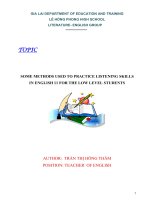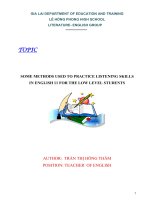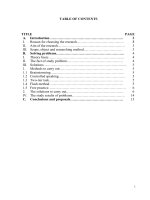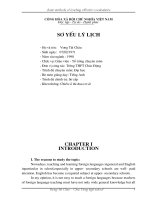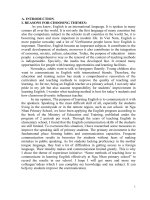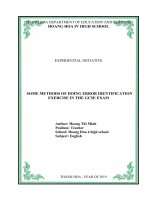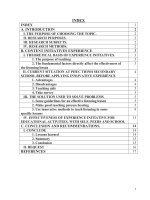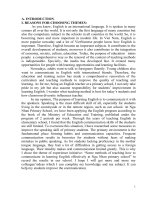Some methods of doing error identification exercise in the GCSE exam
Bạn đang xem bản rút gọn của tài liệu. Xem và tải ngay bản đầy đủ của tài liệu tại đây (586.5 KB, 14 trang )
THANH HOA DEPARTMENT OF EDUCATION AND TRAINING
HOANG HOA IV HIGH SCHOOL
EXPERIENTIAL INITIATIVE
SOME METHODS OF DOING ERROR IDENTIFICATION
EXERCISE IN THE GCSE EXAM
Author: Hoang Thi Minh
Position: Teacher
School: Hoang Hoa 4 high school
Subject: English
THANH HOA , YEAR OF 2019
INDEX
CONTENTS
I. INTRODUCTION
1. Rationale
2. Aims of the study
3. Objects of the study
4. Methods of the study
II. CONTENTS OF THE STUDY
1.Theoretical background
2. Practical background
3.Implimentation and sollution
4. Results after applying the reasearch in teaching
III. CONCLUSION AND SUGGESTION
Reference material
PAGE
2
2
2
2
3
2- 10
2-3
3
3- 10
10
11-13
11
2
I. INTRODUCTION:
1. RATIONALE (Reasons for choosing the topic):
There is no doubt that learning English is very important. Especially,
since the school year 2013-2014, it is compulsary for high school students
throughout Vietnam to do English test in the GCSE exam. This heightens the
need for teachers to investigate alternative approaches to teaching skills that
would lead to significant improvement in students’ marks.
Error identification is one of exercises in the GCSE exam making up 0,6
points which most students have difficulties in identifying the errors.
There are some reasons for this. Firstly, The studens don’t learn English
grammar well (such as verbs tenses, world forms, verb forms, conjunctions,
prepositions .......). Secondly, most teachers mainly focus on teaching the theory
of grammar, they don’t teach students the methods of doing this exercise. When
correcting for the students, the teachers often help their students to identify the
errors directly and explain about these errors. Therefore, students only identify
the errors in specific sentences.
It is for such reasons that my experiential initiative attempts to explore
“ Some methods of doing error identification exercise in the GCSE exam ”
2. AIMS OF THE STUDY:
My school is in the country, most of my students come from poor
families. They learn english without the support of advanced technology such
as: computers, laptops. They don’t have a lot of chances to learn English at
English centers. The studens’ learning English mainly depends on their teachers
and textbooks. I myself take responsibility for the job and create several simply
ways to improve the score of the students in the GCSE exam.
3. OBJECTS OF THE STUDY:
The objects chosen for this study are 12th- form students at Hoang Hoa 4
high school, Thanh Hoa province where I have been teaching for 13 years.
4. METHODS OF THE STUDY:
To achieve the objectives of the study, several methods are used, but I use
mainly quantitative and qualitative methods.
The data serving the research analysis and discussions are collected by
means of a survey questionnaire for students and observation.
II. THE CONTENTS OF THE EXPERIENCE INITIATIVES
1. THEORETICAL BACKGROUND:
English as a language has great reach and influence; it is taught all over
the world. English may not be the most spoken language in the world, but it is
the official language in a large number of countries. English is the language of
science, of aviation, computers, diplomacy, and tourism. Knowing English
increases studens’ chances of getting a good job in a multinational company
within their home country or of finding work abroad.
3
Knowing the methods of doing multiple choice questions, especially the
methods of doing error identification exercise will help the students gain high
score in the GCSE exam.
2. PRACTICAL BACKGROUND:
The study was conducted at Hoang Hoa 4 high school, a rural school of
Thanh Hoa province.
The school has 31 classes, each class consists of from 40 to 46 students.
Most of the students come from the villages in the district where English
learning and teaching does not get much attention. The only sources from which
students can get knowledge are the textbooks and their teachers. With three
periods per week, this is unable for teachers to meet students’ demand. At home,
they are short of dictionaries, reference books, cassette tapes, speakers.
Additionally, their parents do not know anything about English. As a result, they
find it difficult to learn English and they become lazy. I myself has been
teaching English for 13 years. I have a lot of experiences in teaching students
for the GCSE exam. For this exercise, most students have difficulties in
identifying errors (about 90 % don’t know how to do this exercise).
Such practical background has leaded me to my experiential initiative:
“Some methods of doing error identification exercise in the GCSE exam”.
3. IMPLEMENTATION AND SOLUTIONS:
3.1. HOW TO IDENTIFY ERRORS.
Step 1: Read quickly all four underlined words and base on English
grammar to identify the errors.
Step 2: If you finsh step one and you can’t identify the errors, you must
read all the sentences because the errors often relate to the right part of the
sentence.
3.2. THE POPULAR ERRORS IN ERROR IDENTIFICATION
EXERCISE IN THE GCSE EXAM
3.2.1. ERRORS IN VERBS
Errors in verbs often relates to the verb tenses, verb forms, the harmony
between subjects and verbs.
- Verb tenses
These errors relate to using the wrong tense or wrong part of tense. We
can base on the signs of time of the tenses to identify these errors.
Ex1. He saw an accident when he walked to school this morning.
A B
C
D
The correct answer is C (walked => was walking) because this is the use of the
past continuous tense
Ex2. If It didn’t rain hard yesterday, our class could have gone camping
A
B
C
D
The correct answer is A (didn’t rain => hadn’t rained) because this is the
conditional clause of the conditional sentense type 3.
- Verbs in passive or active voice
4
We can base on the meaning of sentence, the subject, or “by” to know the verbs
are used in active or passive voice.
Ex. A new bridge will be build over this river.
A
B
C
D
The correct answer is C (be build => be built)
- Verb forms
These errors relate to Ing-form, to infinitive, infinitive without to or
present participle, past participle.
Ex1. We were advised not drinking the water in the bottle.
A
B
C
D
The correct answer is C (drinking => to drink) because after verb “advise” we
have to use “to infinitive”
Ex2. Establishing in 1984 for students who wanted to study art and music
A
B
subjects , LaGuardia was the first public school of its kind.
C
D
The correct answer is A (Establishing => Established) because in this sentence
we have to use past participle not present participle.
Ex3. It is essential that cancer is diagnosed and treated as early as possible in
A
B
order to assure a successful cure.
C
D
The correct answer is A (is diagnosed => be diagnosed) because this phrase is in
that clause of the structure “It is +adjective+ that +S+ V (bare infinitive)”
- The harmony between subjects and verbs
+ Verbs in the present simple tense
Ex. My mother usually get up late from Monday to Friday.
A
B
C
D
The correct answer is B (get up => gets up) because “My mother” is a singular
noun.
+ Some nouns ending “s” used as a singular nouns
Economics, mathematics, linguistics, informatics, measles, Athens, The United
States ….
Ex. The United States come to of the list of countries ranked by economic
A
B
C
performances.
D
The correct answer is A (come => comes)
+ Subjects are “A number of .........+V (inf )” , “The number of ........+Vs/es”
Ex. A number of large insurance companies has their headquarters in the capital
A
B
C
city.
D
5
The correct answer is B (has => have)
+ Subjects combined by “and”, “both” +Vinf
Ex. Both his mother and he likes listening to music.
A
B
C
D
The correct answer is C (like =>likes)
+ Subjects combined by “either ..... or”, “neither .... nor”, “not only ..... but
also” verbs depending on the second subject
Ex. Not only they but also she like learning English
A
B
C D
The correct answer is B (like => likes) because the subject is “she”
+ Subjects combined by “as well as”, “together with”, “along with”,
“accompanied by” verbs depending the first subject.
Ex. Industrial emissions, together with littering, is causing many problems in
A
B
C
D
our large industrial cities today.
The correct answer is C (is => are) because the subject is “Industrial emissions”
3.2.2. ERRORS IN WORD FORMS
These errors relate to using word forms wrongly between nouns, verbs,
adjectives, adverbs, plural nouns, singular nouns ............
- Misusing adverbs and adjectives
Ex. I feel both excited and nervously because I have an interesting interview
A
B
C
D
tomorrow.
The correct answer is B (nervously => nervous) because after “feel” we use
adjectives not adverbs.
After some verbs such as: be, get, feel, seem, look, smell, taste, keep ....... we
have to use adjectives not adverbs.
- Misusing adjects ending “ing” and adjectives ending “ed”
Ex. Jane is not such a celebrating actress as her mother
A
B
C
D
The correct answer is C (celebrating => celebrated) because “celebrated” the
same meaning with “famous”
- Misusing special adverbs not ending “ly”
Ex. In order to earn a lot of money my father works as harly as possible.
A
B
C
D
The correct answer is D (hardly => hard) because “hard” is an adverb
Some adverbs (hard, fast, late, early) don’t have ending “ly”, which makes us
misuse them
- Errors relate to the order of words in a sentence
Ex. He has taken recently an English course.
A
B
C
D
The correct answer is B (taken recently => recently taken)
6
- Misusing adjectives and nouns
Ex. Higher education is very importance to national economies and it is also a
A
B
source of trained and educated personnel for the whole country.
C
D
The correct answer is A (importance => important) because after “is” and “very”
we have to use an adjective not an adverb.
- Misusing singular nouns, plural nouns, countable and uncountable
nouns .......
Ex. All of the alumnus are attending the reception at the president’s house.
A
B
C
D
The correct answer is A (alummus => alumni) because the plural noun is
“alumni” not “alummus”
- Words connected by “and”, “but” or “or” have the same word form.
Ex. The puppy stood up slowly, waged its tail, blinking its eyes and barked.
A
B
C
D
The correct answer is D (blinking=> blinked)
3.2.3. ERRORS IN PRONOUNS
- Misusing pronouns
Ex. Your house is not so beautiful as my.
A
B
C D
The correct answer is D (my => mine) because we have to use an possessive
pronoun “mine” not possessive adjective “my”
- The harmony between nouns and pronouns.
Ex. Children learn primarily by dirrectly experiencing the world around it.
A
B
C
D
The correct answer is D (it => them)
- Excess pronouns
Ex. A jelly fish, which isn’t really a fish, it has no brain, no bones, and no face.
A
B
C
D
The correct answer is C (it => leave out “it”)
3.2.4. ERRORS IN PREPOSITIONS
- Misuing prepositions after adjectives, verbs, or in idioms
Ex. The boy apologised the woman of breaking her window.
A
B
C
D
The correct answer is B (of => for) because the structure “to apologise sb for”
- Lack of prepositions
Ex. According experts 60,000 cubic feet of earth was thrown into the air in the
A
B
C
D
explosion of Mount St. Helen.
The correct answer is A (According => According to)
- Excess prepositions
7
Ex. Most of people learn English for their jobs.
A
B
C
D
The correct answer is A (Most of =>Most)
3.2.5. ERRORS IN CONFUSING WORDS
- like/ alike
Ex. Alike other forms of energy, natural gas may be used to heat homes, cook
A
B
C
D
food, and even run automobiles.
The correct answer is A( Alike => Like)
- many/ much
Ex. Much people agree that we should protect the environment.
A
B
C
D
The correct answer is A (much => many)
- most/ almost
Ex. Almost poetry is more enjoyable when it is read aloud
A
B
C
D
The correct answer is A (Amost =>Most)
- few/ a few , little/ a little
Ex. I’ve got a few friends and I need to make new friends.
A
B
C
D
The correct answer is B (a few=>few)
- so/ such
Ex. It is so an interesting book that I’ve read it three times.
A
B
C
D
- beside/ besides
Ex. Many small towns have a wooded park besides a lake or stream.
A
B
C
D
The correct answer is C (beside => besides)
- lay/ lie
Ex. She lay the baby down gently on the bed.
A
B
C
D
The correct answer is A (lay => laid)
- despite, in spite of / although, though, eventhough, because/ because of
Ex. Although the bad weather, we decided not to cancel our trip.
A
B
C
D
The correct answer is A (Although => Despite or In spite of ) because after it is a
noun phrase.
- other/ another/ the other
Ex. Some birds perch on branches, while other cling to their trunks.
A
B
C
D
The correct answer is C (other => others)
- make / do
8
Ex. The helicopter can make jobs that no other aircraft can.
A
B
C
D
The correct answer is B (make => do)
- Not/ no
Ex. Because not food is as nutritious for a baby as its mother’s milk, many
A
B
C
D
women are returning to the practice of breast feeding.
The correct answer is A (not food => no good)
- twice/ double
Ex. There are only ten children in the class at the moment but it could be
A
B
twice that after Christmas.
C
D
The correct answer is C (twice => double)
3.2.6. ERRORS IN INVERSION
- Inversion with .......rarely, hardly, never or little, much, nowhere, at no
time, under no circumstance ....
Ex. Little he knows about her.
A
B
C D
The correct answer is B (he knows => does he know)
- Inversion of some structures
+ so ........ that
Ex. So beautiful the girl is that everyone likes her.
A
B
C
D
The correct answer is B (the girl is =>is the girl)
+ Not only .....but also
Ex. Not only she is intelligent but she is also hard-working.
A
B
C
D
The correct answer is B (she is => is she)
+ It was not until ....... that
Ex. Not umtil he came into the light I recognized him.
The correct answer is D (I recognized => did I recognize)
+ No sooner .......than , Hardly .........when
Ex. No sooner I had come home than it rained.
A
B
C
D
The correct answer is B (I had => Had I)
+ Inversion with Only (in, on, at, by, after, when......)
Ex. Only when he grew up he knew about the truth.
A
B
C
D
The correctanswer is C (he knew => did he know)
- Inversion in conditional sentences
Ex. Alex had asked, I would have been able to help.
A
B
C
D
9
The correct answer is A (Alex had asked => Had Alex asked)
3.2.7. ERRORS IN RELATIVE CLAUSES
- Most errors relate to misusing relative pronouns (who, which, that ....)
Ex1. There are many single mothers and single fathers which are raising
A
B
C
D
children by themselves.
The correct answer is C (which => who)
Ex2. He passed the exam with high score, that made his parents happy.
A
B
C D
The correct answer is C (that =>which) because after “,” we don’t use “that”
3.2.8. ERRORS IN REPORTED SPEECH
- These errors relate to not changing tense, time, place in reported speech.
Ex1. The children said that they hadn’t gone to school yesterday.
A B
C
D
The correct answer is D (yesterday => the day before)
Ex2. They said that they will come back again soon.
A B
C
D
The correct answer is C (will =>would)
- Errors relate to the order of elements in reported speech
Ex. Her husband asked her son what did he want for his birthday.
A
B
C
D
The correct answer is C (what did he want => what he wanted)
3.2.9. ERRORS RELATING EXCESS WORDS
- These are some pairs of words which can’t be used together.
Ancient / old
Precede / before
Enter / into
Following / after
Proceed/ forward
Progress / forward
Join / together
First/ original
Incorrect / mistake
Only / unique
Rarely / seldom
Return / back
Repeat / again
Nearly / almost
Reread / again
Tiny / little
Same / identical
Sufficient / enough
New / innovations
Advance / forward
Single / only
giant / huge
Ex1. Once you have finished an article and identified its main ideas, it may not
A
B
be necessary to reread it again.
C
D
The correct answer is D (again => leave it out)
Ex2. Would you like to join together with us ?
A
B C
D
The correct answer is C (together => leave it out )
10
3.2.10. ERRORS RELATING THE LACK OF WORDS
The lack of words may consist of the lack of nouns, pronouns, prepositons,
articles ......
Ex1. World, although once perceived to be limitless, is beginning to reach its
A
B
C
capacity.
The correct answer is A (World => The world)
Ex2. They had difficulty identifying the man committed the crime because of
A
B
C
D
the poor lighting along the street.
The correct answer is B ( The man commited => the man who commited)
4. RESULTS AFTER APPLYING THE RESEARCH IN
TEACHING:
There are three error identification sentences in the GCSE exam making
up 0,6 points.
- The score of the students in the GCSE exam (2016-2017) in classes
which are not applied the research.
Class
12A1
12A3
12A4
Number of
students
45
43
40
0.6 points
%
3 (6,6 %)
2 (4.6%)
2( 5%)
0,4 points
%
6 (13,2 %)
5(11,6%)
4 (10%)
0,2 points
%
15 (33,3 %)
12 (29,9%)
10 ((25%)
0 point
%
21 (53,1%)
24 (53.9%)
24 (60%)
- The score of the students in the GCSE exam (2017-2018) in classes
which are applied the research is much better.
Class
12A2
12A5
12A7
Number of
students
40
44
42
0.6 points
%
12 ((30%)
13 (29,5%)
10 (23,8%)
0,4 points
%
10 (25%)
12 (27,2%)
12 (28,5%)
0,2 points
%
16 (40%)
12(27,2%)
11(26,1%)
0 point
%
2 (5%)
7 (16,1%)
9 (21,6%)
The result has shown that the implementation and solutions used in the
school year 2017-2018 have made the students’score in the GCSE exam much
better.
11
III. CONCLUSION AND SUGGUESTION :
I have found some specific characteristics to create experiental steps singled out
from practical teaching at Hoang Hoa 4 high school in the past school year.
The study has provided students with good methods of doing error identification
exercise. This study will be applied in next years. I will try my best to explore
effective methods to help students to get higher score in the GCSE exam.
To bring students effective school time, I suggest modern educational
equipments should be installed in the classes for the ease of applying technology
in teaching .
I hope my experiential initiative will be received great comments so that I can
promote good points and limit shortcomings next time.
THE CONFIRMATION OF
THE LEADER.
Thanh Hoa, May 25th, 2019
I assure this experiential initiative is written
by myself, I do not copy the others’ content.
HOÀNG THỊ MINH
12
REFERENCE MATERIAL
1. Title test of English subject 2019 - Nguyen Huu Cuong
2. Guide to reviewing graduation exam in English 2018, 2019- Nguyen Huu
Cuong- Ho Huyen- Nguyen Thu Hien
3. Method of doing English test Quiz - Nguyễn Bảo Trang.
4. Method of doing error identification exercise - Nguyen Thi Huyen Trang
5. 104 sentences identifying errrors in the GCSE exam 2018 - Nguyen Thi
Huyen Trang
13
14


